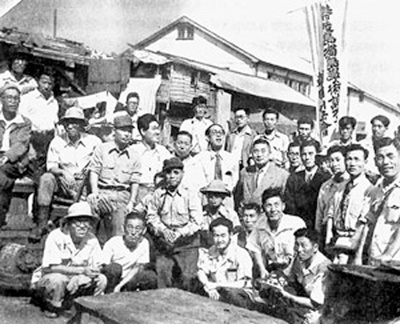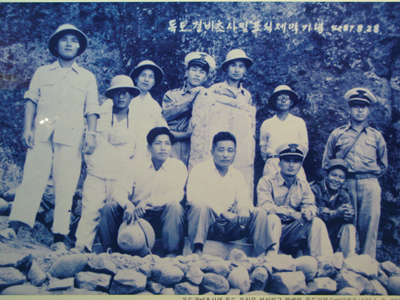- Dokdo in the East Sea
- Educational material
- High School Version
Dokdo in the East Sea
Table of Contents Open Contents
2. Protecting Dokdo
-
- Objectives
-
Examine the efforts of Dokdo Guards and Dokdo Volunteer Guards who served to protect Dokdo.
Explain the protection activities performed by the government as well as civilians.
-
- Critical Thinking
-
South Korea reclaimed sovereignty over Dokdo following liberation after World War II. In the chaos and confusion of the Korean War, however, Japanese people illegally trespassed on Dokdo. How did Koreans guard the island during this time?
Ulleungdo and Dokdo Exploration Team
In August 1945, South Korea became proactive in academic research on Ulleungdo and Dokdo. The interim government named the Civil Administrator An Jae-hong as Chairman of the Interim Legislative Assembly in 1947. In a joint effort with the Corean Alpine Club, exploration teams were sent to Ulleungdo and Dokdo to gather evidence related to sovereignty over Dokdo. The Korean Alpine Club was founded just one month after the country gained independence and pioneered territorial research. Ulleungdo and Dokdo exploration teams were comprised of scholars, journalists, government officials, mountaineers, photographers, and radio-operators, and these people played a central role in providing geographical data to the interim government.
An exploration team departed from Ulleungdo and arrived in Dokdo on August 20, 1947. They raised a signpost on Dongdo and conducted survey and research activities. On Ulleungdo, they conducted research from August 21 to August 25. The team’s achievements were published in newspapers throughout the country, and the fact that Ulleungdo residents referred to Dokdo as Dokseom became widely known.
Although the exploration team attempted two additional expeditions in September 1952, they were forced to return as a result of the Dokdo Bombing Incident.
Rumors of illegal trespassing on Dokdo by Japanese fishermen surfaced in 1953. In response, the Korean government organized an exploration team with the assistance of the Korean Alpine Club. A 30-man team arrived on Dokdo in October 1953 and discovered an illegally installed stone post that read “Takeshima.” It was promptly removed and eventually replaced with a stone post reading “Dokdo.”
The Dokdo Volunteer Guards and the Dokdo Guards
With the liberation of Korea in 1945, Dokdo's Korean sovereignty was naturally restored. As Japan repeatedly invaded Korean territorial waters and even posted a territorial marker to claim Dokdo as Japanese territory, tensions rose between the two countries. Japanese fishermen began to openly trespass in Dokdo beginning in 1953. At this time, South Korea was involved in truce talks with North Korea in addition to discussions regarding the normalization of diplomatic relations with Japan. To counter the frequent Japanese trespassing, an Ulleungdo resident named Hong Sun-jil founded the Dokdo Volunteer Guard with assistance from the police.
Korean police eventually took over the security detail. On June 27, 1996, the Ulleung Guard of the North Gyeongsang-do Police Agency was established with the Dokdo Guards as its subsidiary unit. Dokdo Guards are stationed on Dongdo’s summit, and their facility is equipped with guard posts, a radar station, and a helipad.
-
- Activity 1
-
Examine the activities of the Dokdo Volunteer Guards.
Events and Activities Related to Territorial Sovereignty
Continuous efforts toward preserving Korea’s sovereignty over Dokdo have been made since the founding of the Republic of Korea. After Japan installed a territorial marker on Dokdo in 1953, South Korea’s National Assembly approved a “resolution to protest the Japanese government’s illegal occupation of Dokdo.” The North Gyeongsang-do Council followed with a similar resolution to strengthen Korea’s sovereignty over Dokdo.
The Korean government installed an unmanned lighthouse on Dokdo in August 1954, and informed various government offices in Seoul of this fact. On September 15, 1954, the government issued three commemorative Dokdo postage stamps. A dock was built at Dokdo in February 1996.
Japan sent letters to protest each of these occasions, to which the Korean government replied, “Dokdo is Korean territory and these measures are legitimate exercises of sovereignty.”
Dokdo Residents
People have been residing on Dokdo since 1968. An Ulleungdo fisherman named Choi Jong-deok became the first resident of Dokdo. He began fishing around Dokdo in 1965, and in 1968 he built a permanent residence on the island. He officially registered his residential address as Dokdo in October 1981 and continued to live there until his death in 1987. His daughter Choi Gyeong-suk and her husband moved to Dokdo in July 1986 and lived there as fishers until August 1993. A husband and wife couple became the third generation of Dokdo residents. Kim Sung-do and Kim Sin-ryeol became registered residents of Dokdo in November 1991, and have even participated in elections as Dokdo residents. Kim Sung-do currently is the Dokdo village foreman.
This couple resides on Seodo (West Islet), and two staff members from the Dokdo management office live there, as well. Dongdo (East Islet) is home to 30 Dokdo Guards and three lighthouse keepers. The Dokdo Guards work on a two-month rotation. As of August 2011, the addresses of 2,159 people were registered (family register) under Dokdo despite their not actually residing there.
Dokdo Protection Activities
Efforts to protect the sovereignty of Dokdo are being carried out by both the government and the public. The Korean government enacted the Sustainable Use of Dokdo Act in November 2005 to protect Dokdo and nearby areas. This policy includes provisions for the management and protection of the ecosystem and fisheries, marine mineral resource research and development, and the administration of Dokdo’s facilities.
To coordinate the interagency activities at the central government level, the “Joint Government Dokdo Territorial Management Policy” was instituted in 2008 by the Prime Minister’s office. The “Dokdo Volunteer Guards Act” was enacted in July 2005 to support the bereaved families of volunteers who sacrificed their lives to protect Dokdo. This policy was the basis for the establishment of the “Dokdo Volunteer Guards Memorial Foundation” in March 2009 to celebrate the spirit of the Dokdo Volunteer Guards and support the bereaved. Additional activities are performed by special committees and research teams supported by the National Assembly.
The North Gyeongsang-do and Ulleung County governments are at the forefront of Dokdo protection. North Gyeongsang-do maintains a dedicated Dokdo business team for public relations and research projects. In addition, the province announced in July 2005 that October had been designated Dokdo Month. The An Yong-bok Foundation was established in June 2009. Ulleung County operates the Dokdo Administrative Office and the Dokdo Museum. Ulleung County organized the Dokdo Academy for training civil servants about the history of Dokdo, and also conducts visits to the islands.
Dokdo Museum
The Dokdo Museum was founded on August 8, 1997, in Ulleungdo under the authority of Ulleung County. Lee Jong-hak, the museum’s first curator, collected numerous materials over 30 years. Dokdo-related historical documents and maps, as well as material related to the Dokdo Volunteer Guard, are on display at the museum.
Other Protectors
Government-related Dokdo research institutes include the Northeast Asian History Foundation Dokdo Research Institute, Korea Dokdo and Marine Territory Research Center, KORDI East Sea Research Institute, and Dokdo Information System, among others.
In response to the distortion of history undertaken by Japan, the Korean government established the Truthful History Task Force for Peace in Northeast Asia, and the Northeast Asian History Foundation was established in September 2006. A July 2008 “reference manual on the course of study‘ for Japanese junior high school social studies stipulated the need for students to be taught that Dokdo is Japanese territory. In the wake of this discovery, the Dokdo Research Institute was opened in the Northeast Asian History Foundation for Dokdo-related research and policy development. The Academy of Korean Studies, National Institute of Korean History, and a variety of non-government funded university Dokdo research institutions have been established in the North Gyeongsang-do region. Many other civic organizations also actively participate in the protection of Dokdo.
-
- Activity 2
-
Visit the various Dokdo protection-related websites, and discover ways to become involved in protecting Dokdo.Dokdo-related websites
Corean Alpine Club
In September 1945, a group of explorers and mountaineers founded the Joseon Alpine Club. In 1948, the group’s name was changed to Korean Alpine Club. From 1946 to 1954, the group conducted geographical research expeditions throughout the country. As a part of this project, exploration teams were sent to Ulleungdo and Dokdo in 1947 and 1953.
닫기
reference manual on the course of study
A manual for educators that describes in detail the purpose and content of an education course.
닫기
Dokdo-related websites
• Northeast Asian History Foundation Dokdo Research Institute
( )
• Korea Dokdo and Marine Territory Research Center
( )
KORDI East Sea Research Institute, Dokdo Information System
( )
• Dokdo Museum
( )
• Korea Hydrographic and Oceanographic Administration
( )
• North Gyeongsang Provincial Office, Dokdo Protection Department
( )
• Ulleung County
( )
• Korean Culture and Information Service
( )
• Gyeongbuk Provincial Police Agency, Dokdo Guards
( )
• Korea Coast Guard, Dokdo Guards
( )
( )
• Korea Dokdo and Marine Territory Research Center
( )
KORDI East Sea Research Institute, Dokdo Information System
( )
• Dokdo Museum
( )
• Korea Hydrographic and Oceanographic Administration
( )
• North Gyeongsang Provincial Office, Dokdo Protection Department
( )
• Ulleung County
( )
• Korean Culture and Information Service
( )
• Gyeongbuk Provincial Police Agency, Dokdo Guards
( )
• Korea Coast Guard, Dokdo Guards
( )
닫기

















